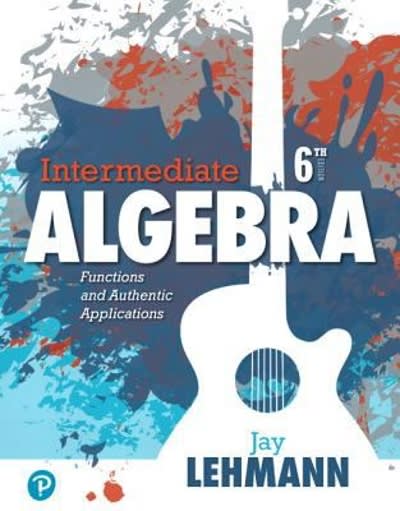Question
Violent crimes includerape, robbery,assault, and homicide. The following is a summary of theviolent-crime rate(violent crimes per100,000 population) for all states of a country in a
Violent crimes includerape, robbery,assault, and homicide. The following is a summary of theviolent-crime rate(violent crimes per100,000 population) for all states of a country in a certain year. Complete parts(a) through(d).
Q1=273.8, Q2=387.9, Q3=528.3
(a) Provide an interpretation of these results. Choose the correct answer below.
A.
75% of the states have aviolent-crime rate that is 273.8 crimes per100,000 population or less.50% of the states have aviolent-crime rate that is 387.9 crimes per100,000 population or less.25% of the states have aviolent-crime rate that is 528.3 crimes per100,000 population or less.
B.
25% of the states have aviolent-crime rate that is 273.8 crimes per100,000 population or less.50% of the states have aviolent-crime rate that is 387.9 crimes per100,000 population or less.75% of the states have aviolent-crime rate that is 528.3 crimes per100,000 population or less.
C.
25% of the states have aviolent-crime rate that is 273.8 crimes per100,000 population or more.50% of the states have aviolent-crime rate that is 387.9 crimes per100,000 population or more.75% of the states have aviolent-crime rate that is 528.3 crimes per100,000 population or more.
(b) Determine and interpret the interquartile range.
The interquartile range is _____crimes per100,000 population.
(Type an integer or adecimal.)
Interpret the interquartile range. Choose the correct answer below.
A.
The middle50% of all observations have a range of 254.5 crimes per100,000 population.
B.
All observations have a range of 254.5 crimes per100,000 population.
C.
The middle50% of all observations have a range of 114.1 crimes per100,000 population.
D.
The middle25% of all observations have a range of 254.5 crimes per100,000 population.
(c) Theviolent-crime rate in a certain state of the country in that year was 1,496. Would this be anoutlier?
The lower fence is ____
crimes per100,000 population.
The upper fence is _____
crimes per100,000 population.
2.A simple random sample of size n=40 is drawn from a population. The sample mean is found to be x=121.3 and the sample standard deviation is found to be s=12.9. Construct a99% confidence interval for the population mean.
The lower bound is____(Round to two decimal places asneeded.)
The upper bound is ____(Round to two decimal places asneeded.)
3.Describe the sampling distribution of
p. Assume the size of the population is 25,000.
n=500, p=0.3
Choose the phrase that best describes the shape of the sampling distribution of
p below.
A.
Not normal because n0.05N and np(1p)10.
B.
Not normal because n0.05N and np(1p)<10.
C.
Approximately normal because n0.05N and np(1p)<10.
D.
Approximately normal because n0.05N and np(1p)10.
Determine the mean of the sampling distribution of p.
^p=____
(Round to one decimal place asneeded.)
Determine the standard deviation of the sampling distribution of p.
^p=____
(Round to three decimal places asneeded.)
4.Which of the following numbers could be the probability of anevent?
0, 1.33, 0.3, 1, 0.51, 0.02
The numbers that could be a probability of an event are ____
(Use a comma to separate answers asneeded.)
5.Oneyear, the mean age of an inmate on death row was 38.9 years. A sociologist wondered whether the mean age of adeath-row inmate has changed since then. She randomly selects 32 death-row inmates and finds that their mean age is 37.8, with a standard deviation of 9.4. Construct a95% confidence interval about the mean age. What does the intervalimply?
Choose the correct hypotheses.
H0: _________. _____
H1: ________. _____
(Type integers or decimals. Do notround.)
Construct a95% confidence interval about the mean age.
With95% confidence, the mean age of a death row inmate is between ____years and ___years. (Round to two decimal places asneeded.)
What does the intervalimply?
A.
Since the mean age from the earlier year is contained in theinterval, there isnot sufficient evidence to conclude that the mean age had changed.
B.
Since the mean age from the earlier year isnot contained in theinterval, there is sufficient evidence to conclude that the mean age had changed.
C.
Since the mean age from the earlier year isnot contained in theinterval, there isnot sufficient evidence to conclude that the mean age had changed.
D.
Since the mean age from the earlier year is contained in theinterval, there is sufficient evidence to conclude that the mean age had changed.
Step by Step Solution
There are 3 Steps involved in it
Step: 1

Get Instant Access to Expert-Tailored Solutions
See step-by-step solutions with expert insights and AI powered tools for academic success
Step: 2

Step: 3

Ace Your Homework with AI
Get the answers you need in no time with our AI-driven, step-by-step assistance
Get Started


